8 minutes read
Construction Unveiled: Video Analytics Benefits
Identify and rectify inefficient processes and resource utilization, save time and money.
Alex Dzyuba
15/11/2023 10:19 AMVideo analytics enables faster and better decision-making, benefiting businesses in multiple ways:
- Cost Savings and Efficiency: Identify and rectify inefficient processes and resource utilization, saving time and money.
- Improved Quality Control: Track and analyze your business processes from start to finish, ensuring consistent delivery of high-quality services or products.
- Instant Insights: Utilize a video analysis system to receive real-time, valuable information, enabling quick decision-making and making your business more agile.
- Competitive Advantage: Gain a competitive edge by leveraging faster and more accurate insights, enabling swift action, increased profit margins, and resource optimization.
Video analytics tools developed by LettiNotes.com empowers businesses to make data-driven decisions, achieve operational excellence, and stay ahead in the market. In this post, we will explore a set of fundamental events derived from video data. Next, we will tailor this set to suit the unique needs of a construction site, showcasing the analytics capabilities derived from the collected data.
Basic set of detected video events
To get build a sophisticated system that can return relevant analytical information we need to start with building blocks — basic events. The simplest set of basic events for our purpose might include, for example, the following events.
- Event 1: The appearance\disappearance of an object from the frame.
- Event 2: An object moving at high speed in the frame.
- Event 3: Camera being blocked by an object.
Let's look at examples of less trivial events.
- Event 4: A person passing through a specific area in the frame.
This event can be used, for example, to monitor doors and corridors.
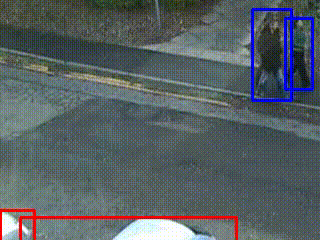
An example of detecting moving objects *.
- Event 5: An object or group of objects being motionless for a certain period.
- Event 6: An object approaching an object or group of objects.
- Event 7: An object moves away from an object or group of objects.
These events can be used to monitor the use of construction equipment and the interaction of workers with it.
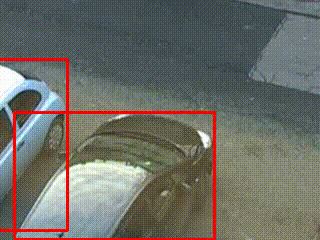
An example of detecting a person leaving a car.
- Event 8: An object entering a defined area in the frame and remaining there for a while.
- Event 9: An object moves away from a specified area in the frame after staying there for some time.
This pair of events can be used to monitor specific areas of the frame.
At LettiNotes.com we can customize above basic events to satisfy the needs of a specific business, in this example: to monitor the activities of a construction site.
Construction site — customized tasks set
We’ll break custom tasks into three groups. First, it is a group of tasks that describes the movement of workers around a construction site. Secondly, a group of tasks reflecting the movement of equipment around the construction site. And thirdly, tasks related to activity at the loading and unloading area.
The first group includes the following tasks:
- Monitoring the work schedule of construction workers.
- Monitoring of certain zones on a construction site, recording the passage of people and construction equipment through these designated areas.
- Monitoring the performance of technological operations, for example, the speed of laying bricks.
Monitoring these tasks ensures optimal resource utilization, adherence to schedules, regulatory compliance, timely project completion, high-quality outcomes, and a safe working environment.
The second group includes the following tasks:
- Monitoring the schedule of movement of construction equipment around the construction site.
- Monitoring the schedule of interaction of workers with construction equipment.
- Monitoring the speed of movement of construction equipment.
The main reasons for monitoring these tasks are:
- Cost Optimization: Sharing equipment between tasks or projects reduces the need for duplicate equipment, resulting in cost savings. Additionally, unauthorized use or misuse of equipment can be detected and addressed, minimizing operational costs.
- Equipment Utilization Analysis: Informed decisions can be made regarding equipment acquisition, rental, or reallocation, maximizing resource utilization and cost-effectiveness.
The third group includes the following tasks:
- Monitoring the schedule for loading construction waste and unloading construction materials.
- Counting the amount of unloaded building materials.
- Recognition of the type of unloaded building materials.
The main reasons for monitoring these tasks are:
- Efficient Waste Management: This helps maintain a clean and safe working environment, preventing potential hazards and promoting efficient waste management practices.
- Smooth Material Logistics: This ensures a smooth workflow, minimizing delays and interruptions caused by insufficient or delayed material supplies.
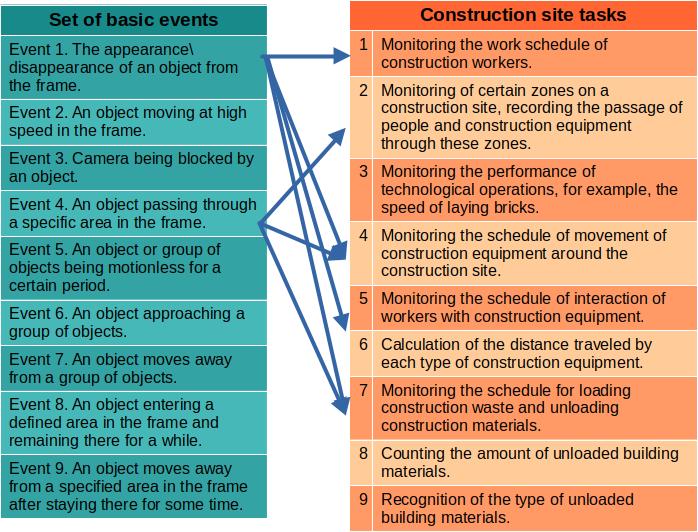
Examples of several connections between basic events set and custom tasks.
The implementation of each custom task includes the detection of several basic video events. The figure shows examples of relationships between tasks and events.
Monitoring results can be visualized in the form of diagrams.
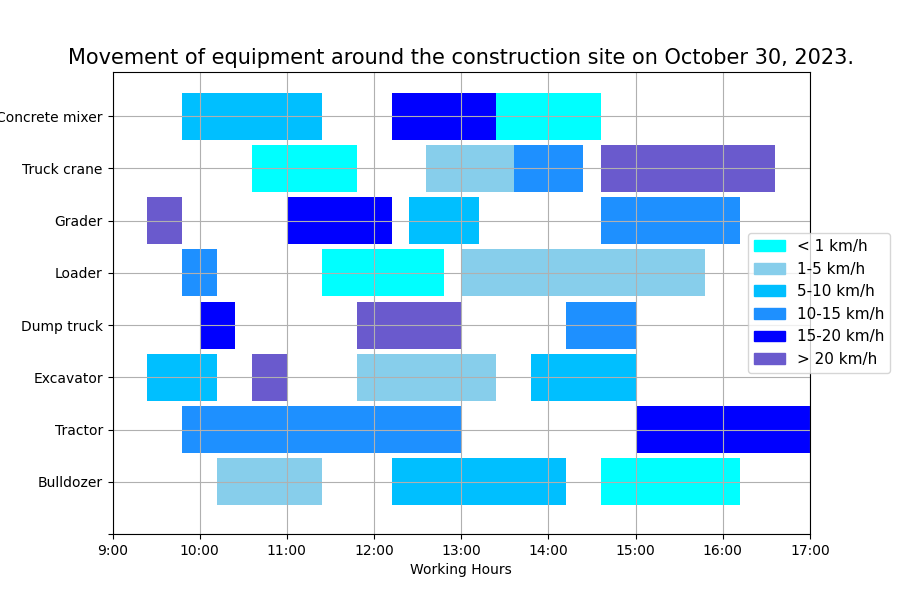
Diagram of the movement of construction equipment around the construction site.
Various custom tasks can be combined on one diagram. For example, situations of interaction of this equipment with workers and other equipment can be superimposed on the diagram of the movement of construction equipment.
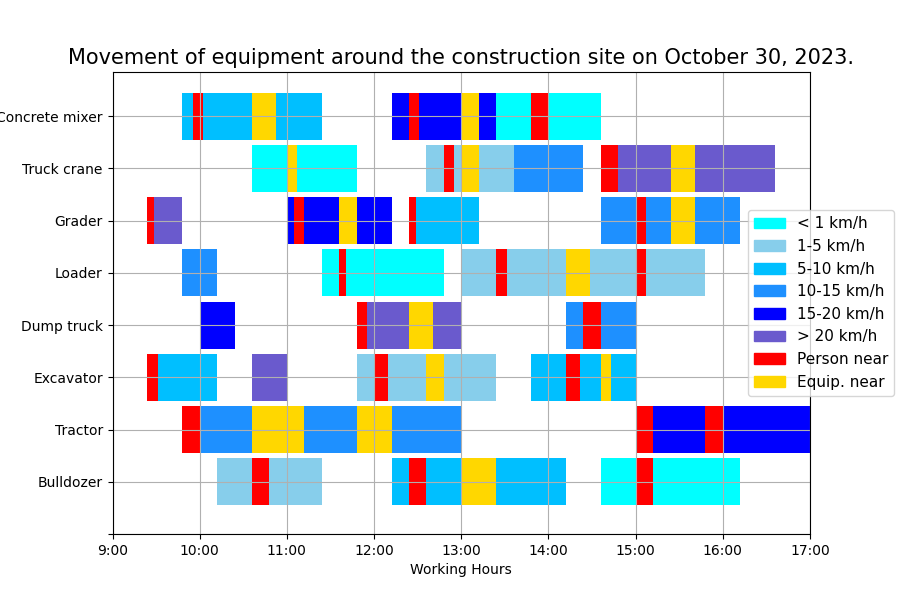
Diagram of the movement of construction equipment around the construction site and interaction with the workers and another equipment.
Various types of visual diagrams can be used. Here is an example of monitoring the number of workers in different areas of a construction site.
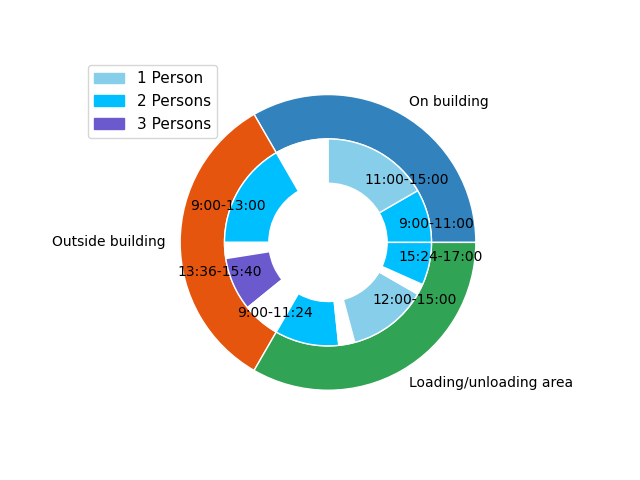
Distribution of workers in different areas of the construction site.
Conclusion
Businesses are interested in using video analytics to make more money, provide better customer service, and find and fix problems. By studying hidden patterns in video data, businesses can discover valuable insights that help them make smarter decisions, predict future trends, get rid of inefficiencies, take advantage of customer buying habits, and improve their marketing.
In this post, we customized a basic set of video events for just one specific business - a construction site. However, similar customization of the basic set of events can be done for other businesses. For example, for restaurants, cafes, retail and convenience stores, warehouses, parking lots …
The algorithms developed by LettiNotes have the capability to detect and track objects in the frame. They also consider the relationships between events and the context of the current situation. These algorithms can effectively process low-resolution videos captured in low light conditions. This addresses both privacy requirements and the typical lighting conditions in the environments we serve.
* S. J. Blunasden, R. B. Fisher, "The BEHAVE video dataset: ground truthed video for multi-person behavior classification" , Annals of the BMVA, Vol 2010(4), pp 1-12.
Alex Dzyuba
Sales Manager
Interested in Deep Learning, Predictive Modelling, Statistical Analysis.